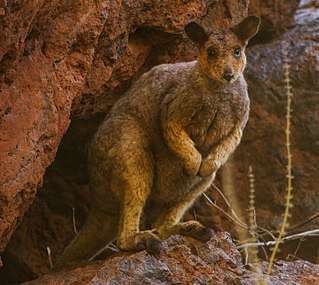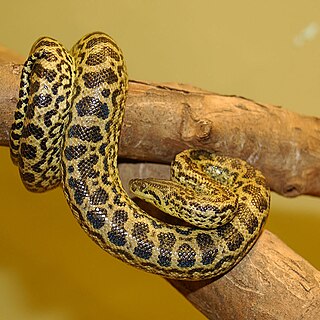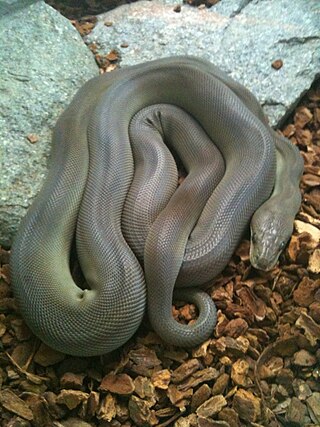
The Pythonidae, commonly known as pythons, are a family of nonvenomous snakes found in Africa, Asia, and Australia. Among its members are some of the largest snakes in the world. Ten genera and 39 species are currently recognized. Being naturally non-venomous, pythons must constrict their prey to suffocate it prior to consumption. Pythons will typically strike at and bite their prey of choice to gain hold of it; they then must use physical strength to constrict their prey, by coiling their muscular bodies around the animal, effectively suffocating it before swallowing whole. This is in stark contrast to venomous snakes such as the rattlesnake, for example, which delivers a swift, venomous bite but releases, waiting as the prey succumbs to envenomation before being consumed. Collectively, the pythons are well-documented and -studied as constrictors, much like other non-venomous snakes, including the boas and even kingsnakes of the New World.

The Top End of Australia's Northern Territory is a geographical region encompassing the northernmost section of the Northern Territory, which aside from the Cape York Peninsula is the northernmost part of the Australian continent. It covers a rather vaguely defined area of about 245,000 km² behind the northern coast from the Northern Territory capital of Darwin across to Arnhem Land with the Indian Ocean on the west, the Arafura Sea to the north, and the Gulf of Carpentaria to the east, and with the almost waterless semi-arid interior of Australia to the south, beyond the huge Kakadu National Park.

Antaresia is a genus of pythons, nonvenomous snakes in the family Pythonidae. The genus is native to Australasia. The genus is known by the common name Children's pythons, the name of the type species, Antaresia childreni. Gray named A. childreni in honour of his mentor, John George Children, who was a curator of the zoological collection at the British Museum around that time. It contains the smallest members of the Pythonidae. Four species and two subspecies are recognized, although they were all considered part of the same species until recently. A newly described form called the pygmy banded python may be a distinct species, but analysis has not yet been performed on this animal. The largest recorded examples of Antaresia species have all been males, suggesting males of the known species in this genus may compete for females. This behavior has never been witnessed in the wild, and has only been witnessed in captive specimens.

The green tree python is a species of snake in the family Pythonidae. The species is native to New Guinea, some islands in Indonesia, and the Cape York Peninsula in Australia. First described by Hermann Schlegel in 1872, it was known for many years as Chondropython viridis. As its common name suggests, it is a bright green snake that can reach a total length of 2 m (6.6 ft) and a weight of 1.6 kg (3.5 lb), with females slightly larger and heavier than males. Living generally in trees, the green tree python mainly hunts and eats small reptiles and mammals. It is a popular pet, and numbers in the wild have suffered with large-scale smuggling of wild-caught green tree pythons in Indonesia. Despite this, the green tree python is rated as least concern on the IUCN Red List of endangered species.

Tiger snakes are a large and highly venomous snake of southern Australia, including its coastal islands and Tasmania. These snakes are often observed and locally well known by their banding, black and yellow like a tiger, although the species can be highly variable in coloration and patterning. All populations are classified within the genus Notechis (Elapidae). Their diverse characteristics have been classified either as distinct species or by subspecies and regional variation.

The Indian python is a large python species native to tropical and subtropical regions of the Indian subcontinent and Southeast Asia. It is also known by the common names black-tailed python, Indian rock python, and Asian rock python. Although smaller than its close relative the Burmese python, it is still among the largest snakes in the world. It is generally lighter colored than the Burmese python and reaches usually 3 m. Like all pythons, it is nonvenomous.

Threatened fauna of Australia are those species and subspecies of birds, fish, frogs, insects, mammals, molluscs, crustaceans and reptiles to be found in Australia that are in danger of becoming extinct. This list is the list proclaimed under the Australian federal Environment Protection and Biodiversity Conservation Act 1999. The classifications are based on those used by the World Conservation Union (IUCN), however IUCN and Australian rankings do differ. Each state and territory has its own legislation relating to environmental protection.

Children's python is a species of nonvenomous snake in the family Pythonidae. The species is named after John George Children. It is a nocturnal species occurring in the northern half of Australia and generally found on the ground, although it often climbs trees. Usually growing to about 1.0 m (3 ft) in length or more depending on the polymorphic variant, it is typically a reddish-brown colour, darker on the upper surface, and with many darker blotches, especially on younger specimens. The Stimson's python variant has much stronger and more variable colors; often being adorned with reddish-brown to chocolate blotches against lighter tan. It feeds mostly on small mammals and birds, and as with other pythons, it constricts its prey before swallowing it whole. It is a popular pet among reptile enthusiasts.

The amethystine python, also known as the scrub python or sanca permata in Indonesian, is a species of non-venomous snake in the family Pythonidae. The species is found in Indonesia and Papua New Guinea. Popular among reptile enthusiasts, and noted for its coloration and size, it is one of the largest snakes in the world, as measured either by length or weight, and is the largest native snake in Papua New Guinea. Until 2000, the larger S. kinghorni was generally considered a subspecies of S. amethistina, and this change of classification has still not been universally reflected in literature. Because of this issue, S. amethistina has often been described as the largest snake in Australia, but this is not accurate since under the current classification, this species does not occur in Australia.

The Oenpelli python or Oenpelli rock python is a species of large snake in the family Pythonidae. The species is endemic to the sandstone massif area of the western Arnhem Land region in the Northern Territory of Australia. There are no subspecies that are recognised as being valid. It has been called the rarest python in the world. Two notable characteristics of the species are the unusually large size of its eggs and its ability to change colour.

Rothschild's rock-wallaby – sometimes known as the Roebourne rock-wallaby, is a species of macropod found in Western Australia, in the Pilbara district and the Dampier Archipelago. It is not currently considered to be threatened, but is at risk from the red fox.

Sydney Zoo is a zoo in Bungarribee in the Western Sydney Parklands, in Greater Western Sydney, New South Wales, Australia. Sydney Zoo is located 38 kilometres (24 mi) west of the Sydney central business district. It occupies a 16.5-hectare (41-acre) site. Sydney Zoo is a member of the Zoos and Aquariums Association of Australia and New Zealand.

The yellow anaconda, also known as the Paraguayan anaconda, is a boa species endemic to southern South America. It is one of the largest snakes in the world but smaller than its close relative, the green anaconda. No subspecies are currently recognized. Like all boas and pythons, it is non-venomous and kills its prey by constriction.

Morelia spilota spilota is a subspecies of carpet python, popularly known as the diamond python. It is a medium to large snake, found in coastal areas and adjacent ranges of south-eastern Australia. It is the most southerly occurring python in the world and is found at higher altitudes than any other species of Australian python.

The olive python is a species of snake in the family Pythonidae. The species is endemic to Australia. Two subspecies are recognized, including the nominate subspecies described here.
The Bluff Downs giant python is an extinct species of snake from Queensland, Australia, that lived during the Early Pliocene. Named in 2002, Liasis dubudingala was likely the biggest snake found in Australia, with a total length of up to 9 m (30 ft). This length rivals the largest extant snake species, the reticulated python from Asia and the green anaconda from South America. It may have fed on larger prey such as juvenile diprotodontids, but it is also possible that it was a skilled climber capable of catching birds and arboreal marsupials.

The Australian scrub python, or simply scrub python is a species of snake in the family Pythonidae. The species is indigenous to forests of northern Australia. It is one of the world's longest and largest snakes, and is the longest and largest in Australia. Recently, it has been reclassified to the genus Simalia alongside a few other former Morelia species, but scientific debate over this continues.

The Pilbara shrublands is a deserts and xeric shrublands ecoregion in Western Australia. It is coterminous with the Pilbara IBRA region. For other definitions and uses of "Pilbara region" see Pilbara.















